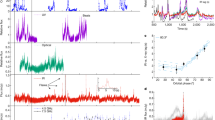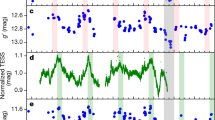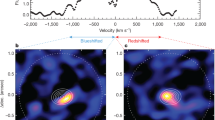Abstract
Although disk accretion onto compact objects—white dwarfs, neutron stars and black holes—is central to much of high-energy astrophysics, the mechanisms that enable this process have remained observationally difficult to determine. Accretion disks must transfer angular momentum in order for matter to travel radially inward onto the compact object1. Internal viscosity from magnetic processes1,2,3,4 and disk winds5 can both in principle transfer angular momentum, but hitherto we lacked evidence that either occurs. Here we report that an X-ray-absorbing wind discovered in an observation of the stellar-mass black hole binary GRO J1655 - 40 (ref. 6) must be powered by a magnetic process that can also drive accretion through the disk. Detailed spectral analysis and modelling of the wind shows that it can only be powered by pressure generated by magnetic viscosity internal to the disk or magnetocentrifugal forces. This result demonstrates that disk accretion onto black holes is a fundamentally magnetic process.
This is a preview of subscription content, access via your institution
Access options
Subscribe to this journal
Receive 51 print issues and online access
$199.00 per year
only $3.90 per issue
Buy this article
- Purchase on Springer Link
- Instant access to full article PDF
Prices may be subject to local taxes which are calculated during checkout


Similar content being viewed by others
References
Shakura, N. I. & Sunyaev, R. A. Black holes in binary systems. Observational appearance. Astron. Astrophys. 24, 337–355 (1973)
Balbus, S. A. & Hawley, J. F. A powerful local shear instability in weakly magnetized disks. Astrophys. J. 376, 214–233 (1991)
Hawley, J. F., Gammie, C. F. & Balbus, S. A. Local three-dimensional magnetohydrodynamic solutions of accretion disks. Astrophys. J. 440, 742–763 (1995)
Balbus, S. A. & Hawley, J. F. Instability, turbulence, and enhanced transport in accretion disks. Rev. Mod. Phys. 70, 1–53 (1998)
Blandford, R. D. & Payne, D. G. Hydromagnetic flows from accretion disks and the production of radio jets. Mon. Not. R. Astron. Soc. 199, 883–903 (1982)
Orosz, J. & Bailyn, C. D. Optical observations of GRO J1655 - 40 in quiescence. I. A precise mass for the black hole primary. Astrophys. J. 477, 876–896 (1997)
Hjellming, R. M. & Rupen, M. P. Episodic ejection of relativistic jets by the X-ray transient GRO J1655 - 40. Nature 375, 464–468 (1995)
Dickey, J. M. & Lockman, F. J. H I in the Galaxy. Annu. Rev. Astron. Astrophys. 28, 215–261 (1990)
Verner, D. A., Verner, E. M. & Ferland, G. J. Atomic data for permitted resonance lines of atoms and ions from H to Si, and S, Ar, Ca, and Fe. Atom. Data Nucl. Data Tables 64, 11–180 (1996)
The NIST Atomic Spectra Database, Standard Reference Database 78. http://physics.nist.gov/cgi-bin/AtData/main.asd (2005).
Nahar, S. & Pradhan, A. K. Atomic data from the Iron Project. XXXV. Relativistic fine structure oscillator strengths for Fe XXIV and Fe XXV. Astron. Astrophys. Suppl. 135, 347–357 (1999)
Raymond, J. A model of an X-ray-illuminated accretion disk and corona. Astrophys. J. 412, 267–277 (1993)
Miller, J. M. et al. Chandra/HETGS spectroscopy of the Galactic black hole GX 399 - 4: A relativistic iron emission line and evidence for a Seyfert-like warm absorber. Astrophys. J. 601, 450–465 (2004)
Colgan, J., Pindzola, M. S. & Badnell, N. R. Dielectronic recombination data for dynamic finite-density plasmas. V: the lithium isoelectronic sequence. Astron. Astrophys. 417, 1183–1188 (2004)
Spitzer, L. Physical Processes in the Interstellar Medium (Wiley, New York, 1978)
Grevesse, N. & Sauval, A. J. in Solar Composition and its Evolution–from Core to Corona (eds Frölich, C., Huber, M. C. E., Solanski, S. K. & von Steiger, R.) 161–174 (Kluwer, Dordrecht, 1998)
Vrtilek, S. et al. Observations of Cygnus X-2 with IUE—Ultraviolet results from a multi-wavelength campaign. Astron. Astrophys. 234, 162–173 (1990)
Begelman, M. C., McKee, C. F. & Shields, G. A. Compton heated winds and coronae above accretion disks. II Dynamics. Astrophys. J. 271, 70–89 (1983)
Chelouche, D. & Netzer, H. Dynamical and spectral modeling of the ionized gas and nuclear environment in NGC 3783. Astrophys. J. 625, 95–107 (2005)
Proga, D., Stone, J. M. & Kallman, T. R. Dynamics of line-driven winds in active galactic nuclei. Astrophys. J. 543, 686–696 (2000)
Miller, K. A. & Stone, J. M. The formation and structure of a strongly magnetized corona above a weakly magnetized accretion disk. Astrophys. J. 534, 398–419 (2000)
Proga, D. Numerical simulations of mass outflows driven from accretion disks by radiation and magnetic forces. Astrophys. J. 585, 406–417 (2003)
Spruit, H. C. in Physical Processes in Binary Stars (eds Wijers, R. A. M. J., Davies, M. B. & Tout, C. A.) 249–286 (NATO ASI Ser., Kluwer, Dordrecht, 1996)
Calvet, N., Hartmann, L. & Kenyon, S. J. Mass loss from pre-main-sequence accretion disks. I—The accelerating wind of FU Orionis. Astrophys. J. 402, 623–634 (1993)
Schulz, N. S. & Brandt, W. N. Variability of the X-ray P Cygni line profiles from Cicinus X-1 near zero phase. Astrophys. J. 572, 972–983 (2002)
Mauche, C. W. & Raymond, J. C. Extreme Ultraviolet Explorer observations of OY Carinae in superoutburst. Astrophys. J. 541, 924–936 (2000)
Konigl, A. & Kartje, J. F. Disk-driven hydromagnetic winds as a key ingredient of active galactic nuclei unification schemes. Astrophys. J. 434, 446–467 (1994)
Everett, J. E. Radiative transfer and acceleration in magnetocentrifugal winds. Astrophys. J. 631, 689–706 (2005)
Houck, J. C. & Denicola, L. A. ISIS: An interactive spectral interpretation system for high resolution X-ray spectroscopy. Astron. Soc. Pacif. Conf. Proc. 216, 591–594 (2000)
Acknowledgements
We acknowledge conversations with N. Calvet, L. Hartmann, D. Proga and M. Rupen. We are indebted to A. Prestwich, H. Tananbaum and the Chandra staff for help in making this observation possible. We thank B. Lauritsen for editorial insights. This work was supported by NASA through the Chandra guest observer programme (J.M.M.). Author Contributions J.M.M. analysed the Chandra data and wrote most of the paper. J.R. developed the photoionization model. J.M.M., J.R., A.F. and C.R. developed the interpretation of the data. D.S., J.H., M.K. and R.W. contributed insights on X-ray binaries and/or made supporting observations with other instruments. All others discussed the work at length, and contributed to the manuscript.
Author information
Authors and Affiliations
Corresponding author
Ethics declarations
Competing interests
Reprints and permissions information is available at npg.nature.com/reprintsandpermissions. The authors declare no competing financial interests.
Supplementary information
Supplementary Notes
This file contains Supplementary Figures 1 and 2 and Supplementary Tables. (PDF 340 kb)
Rights and permissions
About this article
Cite this article
Miller, J., Raymond, J., Fabian, A. et al. The magnetic nature of disk accretion onto black holes. Nature 441, 953–955 (2006). https://doi.org/10.1038/nature04912
Received:
Accepted:
Issue Date:
DOI: https://doi.org/10.1038/nature04912
This article is cited by
-
Vertical wind structure in an X-ray binary revealed by a precessing accretion disk
Nature Astronomy (2023)
-
Frontiers in accretion physics at high X-ray spectral resolution
Nature Astronomy (2022)
-
Ionized outflows from active galactic nuclei as the essential elements of feedback
Nature Astronomy (2020)
-
Magnetic origin of black hole winds across the mass scale
Nature Astronomy (2017)
Comments
By submitting a comment you agree to abide by our Terms and Community Guidelines. If you find something abusive or that does not comply with our terms or guidelines please flag it as inappropriate.



